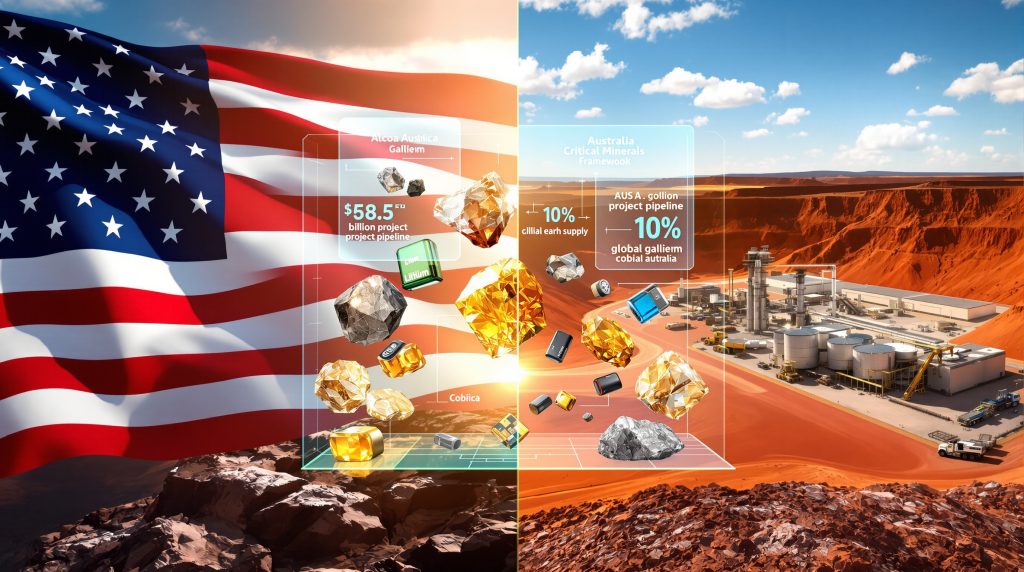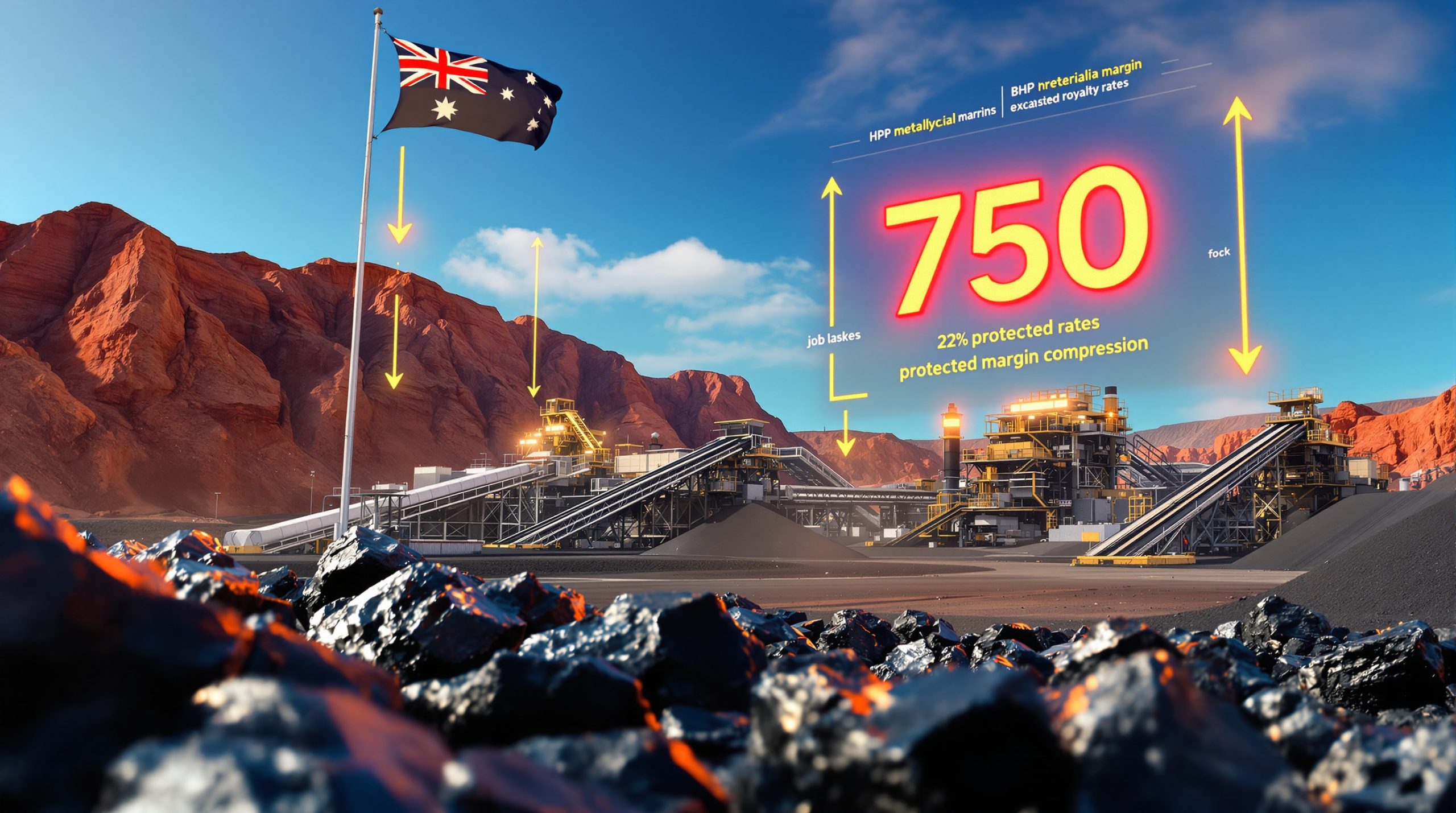How Does the Framework Address Global Supply Chain Vulnerabilities?
The US and Australia rare earths supply chain agreement represents a strategic response to decades of concentrated mineral processing, particularly China's dominance of approximately 70% of global rare earth element processing capacity. This bilateral partnership creates alternative pathways for critical material procurement while establishing coordinated defense mechanisms against supply chain disruptions.
Diversification Away from Single-Source Dependencies
The framework tackles the fundamental risk of over-reliance on concentrated supply sources by developing parallel processing capabilities across democratic nations. Both countries recognise that supply chain concentration creates national security vulnerabilities, especially for materials essential to clean energy transitions and advanced defence systems.
Historical supply disruptions, such as China's 2010 rare earth export restrictions, demonstrated how single-source dependencies can paralyse entire industrial sectors. The semiconductor industry, which relies heavily on gallium imports, faces particular vulnerability with approximately 80% of US semiconductor inputs sourced internationally.
Investment Mobilisation Mechanisms
The agreement establishes unprecedented financial commitments designed to accelerate project development across Australian mining operations. Each nation commits a minimum $1 billion within the first six months of implementation, creating immediate capital availability for priority projects.
Financial Commitment Structure:
- Each nation deploys minimum $1 billion within six-month implementation period
- Combined $8.5 billion project pipeline targeting Australian operations
- Coordinated financing through loans, guarantees, and equity participation
- Streamlined approval processes to accelerate project timelines from typical 3-5 years to expedited schedules
The coordinated stockpiling approach integrates the US strategic petroleum and minerals reserve system with Australia's strategic minerals reserve, creating buffer capacity that reduces single-point-of-failure vulnerabilities during geopolitical tensions or natural disasters.
Which Critical Minerals Are Prioritised Under This Agreement?
The US and Australia rare earths supply chain agreement focuses on specific minerals that represent both strategic vulnerability and opportunity for market diversification. Two flagship projects demonstrate the partnership's immediate implementation priorities.
Gallium Recovery Operations
The Alcoa-Sojitz facility in Western Australia emerges as a cornerstone initiative, designed to supply approximately 10% of global gallium demand. This semiconductor-grade material proves essential for advanced electronics, integrated circuits, and defence applications requiring extremely high purity levels of 99.9999% or greater.
Global gallium production currently reaches approximately 250 metric tons annually, with integrated circuit applications accounting for roughly 95% of total usage. The semiconductor industry's demand for gallium has increased 8-10% annually over the past decade, driven by 5G infrastructure deployment, data centre expansion, and artificial intelligence chip development.
Rare Earth Element Processing
The Nolans Project in Northern Territory, operated by Arafura Rare Earths Limited (ASX: ARU), targets 5% of worldwide rare earth production. This operation focuses particularly on heavy rare earth elements including dysprosium and terbium, which are essential for permanent magnets used in wind turbines and electric vehicle motors.
A single 2-3 megawatt wind turbine requires approximately 600 kg of rare earth elements (primarily neodymium) for its permanent magnet generator. With global wind energy capacity expected to grow from 1,050 GW in 2024 to 2,000+ GW by 2030, rare earth element demand from the wind sector alone faces substantial expansion.
Key Mineral Categories Include:
| Mineral Type | Strategic Application | Supply Target | Processing Location |
|---|---|---|---|
| Gallium | Semiconductors, Defence Electronics | 10% global supply | Western Australia |
| Rare Earth Elements | Clean Energy, Advanced Manufacturing | 5% global supply | Northern Territory |
| Lithium | Battery Technology, Energy Storage | Under evaluation | TBD |
| Cobalt | Electric Vehicle Batteries | Under evaluation | TBD |
What Governance Structure Oversees Implementation?
The framework establishes a dual-leadership governance model designed to ensure equal partnership while maintaining institutional continuity across political administrations.
Joint Response Group Formation
The US-Australia Critical Minerals Supply Security Response Group operates under co-leadership from the US Secretary of Energy and Australian Minister for Resources. This coordination body identifies priority materials, monitors supply vulnerabilities, and orchestrates emergency response protocols during disruption events.
The Response Group functions include:
- Identifying priority minerals based on supply vulnerability assessments
- Monitoring supply chain vulnerabilities in real-time
- Orchestrating emergency response protocols during supply disruptions
- Coordinating between government agencies and private sector stakeholders
Ministerial Review Process
A Mining, Minerals and Metals Investment Ministerial convenes within 180 days of the October 20, 2025 framework signing (approximately April 2026) to evaluate progress and identify additional opportunities for bilateral cooperation. This formal review mechanism creates accountability measures and adaptation capabilities as market conditions evolve.
The establishment of formally designated institutional structures creates permanence beyond individual political administrations, ensuring continuity of strategic cooperation regardless of electoral changes in either nation.
How Will This Impact Australia's Mining Sector?
Australia's mining sector stands to benefit substantially from the US and Australia rare earths supply chain agreement through accelerated project development, streamlined regulatory processes, and enhanced investment attraction.
Regulatory Streamlining Benefits
The framework introduces accelerated approval pathways specifically for critical mineral operations, reducing standard permitting timelines through several mechanisms:
- Pre-approved environmental assessment protocols
- Expedited Indigenous engagement processes
- Coordinated federal-state approval coordination
- Streamlined permitting for qualifying mineral ventures
Traditional Australian mining project approvals typically span 3-5 years; the accelerated processes aim to significantly reduce these timelines while maintaining environmental and social safeguards.
Investment Attraction Potential
According to Minerals Council of Australia estimates, the partnership could unlock an $8.5 billion project pipeline while reinforcing Australia's position as a trusted global supplier of strategic materials. MCA CEO Tania Constable characterised the framework as acknowledging Australia's strategically important role in developing new technologies, defence capabilities, and renewable energy infrastructure.
Furthermore, Australia's green metals leadership position strengthens through this partnership, creating competitive advantages in sustainable mineral processing and extraction technologies.
Strategic Assessment: This partnership enhances Australia's reputation as a place to do business and will encourage greater investment in Australian mining and processing at a time when it's urgently required to unlock the nation's next chapter of prosperity.
The framework leverages existing infrastructure advantages, such as the Alcoa-Sojitz partnership's use of established alumina refining infrastructure in Western Australia, reducing capital requirements for new mineral extraction operations.
Strategic Reserve Integration
Australia's Critical Minerals Strategic Reserve creates buffer inventory separate from commercial supply chains, allowing government intervention to stabilise markets during supply disruptions while supporting strategic stockpile development for allied nations.
What Are the Broader Geopolitical Implications?
The US-Australia critical minerals framework extends beyond bilateral trade cooperation to establish a template for democratic nations securing strategic resource supply chains through transparent, rules-based mechanisms.
AUKUS Connection and Defence Integration
The framework represents an expansion of the AUKUS security partnership (Australia-UK-US), which was established in September 2021 initially focusing on nuclear-powered submarines. Critical minerals cooperation demonstrates that modern national security encompasses supply chain resilience alongside traditional defence capabilities.
Critical minerals function as enabling inputs for advanced defence systems:
- Advanced radar and communications systems requiring rare earth magnets
- Semiconductor-based defence electronics utilising gallium
- Energy storage systems for military vehicles using cobalt and lithium
- Hypersonic weapons development requiring specialised rare earth alloys
According to Tania Constable's assessment, this represents AUKUS in action through shared interests, shared defence capabilities, shared minerals and technologies, and critically, shared investment commitments.
Market Stability Mechanisms
The agreement includes coordinated measures to protect domestic markets from non-market practices and unfair trade behaviour, addressing concerns about predatory pricing, export monopolisation, and strategic material withholding. These provisions establish price stability protocols that benefit industries dependent on consistent critical mineral supplies.
The framework contrasts with centralised state control models by emphasising transparent cooperation mechanisms that comply with international trade rules while achieving strategic objectives. In addition, this approach considers critical minerals & energy security as complementary objectives rather than competing priorities.
How Does Recycling and Circular Economy Factor In?
Circular economy approaches within the framework address both supply security and environmental sustainability through advanced recycling technology development and scrap recovery optimisation.
Technology Development Priorities
Both nations commit to advancing minerals recycling and scrap recovery technologies, recognising that circular economy approaches can simultaneously reduce primary extraction requirements while maintaining supply security through secondary sources.
Current recycling rates demonstrate significant improvement opportunities:
- Rare earth elements: Global recycling rate approximately 1% due to technological challenges and limited scrap availability
- Gallium: Secondary gallium recovery achieves approximately 5-10% globally
- Lithium: Lithium-ion battery recycling reaches approximately 5% globally, though controlled programmes achieve 50%+ recovery rates
Recent developments in battery recycling breakthrough technologies demonstrate the potential for substantial improvements in secondary material recovery rates across the critical minerals sector.
Sustainability Integration
Recycling technology challenges include complex separation processes:
- Rare earth element separation requires sophisticated hydrometallurgical or pyrometallurgical techniques with energy intensity comparable to primary extraction
- Gallium recovery demands specialised processes for integrated circuit scrap recovery, limiting recyclability to specific circuit types
- Lithium recovery utilises emerging direct extraction technologies from battery electrolytes, though economic viability remains marginal at current lithium prices
According to lifecycle assessments, by 2035-2040, recycled critical minerals could supply 20-30% of demand for gallium and lithium as accumulated battery retirement volumes create substantial secondary material availability.
What Timeline and Milestones Define Success?
The framework establishes specific implementation phases with measurable commitments designed to create immediate momentum while building long-term strategic capabilities.
Six-Month Implementation Phase
The initial deployment period requires both nations to mobilise minimum $1 billion investment within six months of the October 20, 2025 signing. Priority actions include:
- Priority project initiation for gallium and rare earth operations
- Regulatory framework establishment for accelerated approvals
- Financial mechanism activation for loans, guarantees, and equity participation
- Joint Response Group operational establishment
180-Day Ministerial Review
Scheduled for approximately April 20, 2026, the comprehensive ministerial assessment evaluates progress across all framework elements, identifies additional cooperation opportunities, and provides strategic direction refinement through formal consultation between US and Australian leadership.
The review process creates accountability measures while allowing framework adaptation as market conditions and geopolitical circumstances evolve. However, the framework must also consider potential policy changes, including Trump's critical minerals order and its implications for bilateral cooperation.
How Will This Framework Influence Global Critical Mineral Markets?
The US and Australia rare earths supply chain agreement creates market dynamics that extend far beyond bilateral trade relationships, influencing global pricing, supply chain resilience, and technology development across critical mineral sectors.
Supply Chain Resilience Enhancement
The partnership establishes alternative supply pathways that reduce global market volatility while providing stability for industries dependent on critical materials. By creating processing capabilities outside of concentrated supply sources, the framework reduces price manipulation risks and ensures consistent material availability during geopolitical tensions.
Technology Transfer and Innovation
Joint research and development initiatives accelerate processing technology advancement, potentially reducing extraction and processing costs while improving efficiency across the entire supply chain. Shared technological development creates competitive advantages for democratic nations while establishing higher environmental and social standards.
Market Impact Projections:
- Enhanced supply security reducing semiconductor industry vulnerability
- Reduced price volatility for rare earth elements through diversified processing
- Accelerated clean energy technology deployment through reliable material supplies
- Strengthened defence supply chain resilience across allied nations
What Challenges and Opportunities Lie Ahead?
While the framework establishes clear policy direction and financial commitments, successful implementation requires coordination across multiple government agencies, private sector stakeholders, and international partners.
Implementation Complexity
The bilateral cooperation demands seamless integration between different regulatory systems, environmental standards, and business practices. Coordinating accelerated approval processes while maintaining environmental safeguards requires careful balance between development speed and responsible resource extraction.
Technical challenges include developing processing capabilities that can compete economically with established operations while meeting the quality specifications required for advanced technology applications.
Environmental and Social Considerations
Balancing rapid development with environmental stewardship and community engagement remains crucial for long-term sustainability and social licence to operate. Mining operations must demonstrate responsible resource extraction while contributing meaningfully to local and regional economic development.
Furthermore, the partnership must navigate potential trade tensions and supply disruptions while maintaining commitment to transparent, rules-based cooperation mechanisms.
Strategic Outlook: This bilateral framework represents more than a trade agreement. It establishes a template for democratic nations to secure critical resource supply chains while maintaining commitment to transparency, environmental responsibility, and fair market practices.
The partnership positions both nations to lead in the global transition toward clean energy while ensuring national security interests remain protected through diversified, resilient supply chains that reduce dependence on concentrated processing capabilities.
Disclaimer: This analysis contains forward-looking assessments based on publicly available information as of October 2025. Market conditions, political circumstances, and project development timelines may change, affecting actual outcomes. Investment decisions should consider comprehensive due diligence and professional financial advice.
Ready to Capitalise on Critical Minerals Investment Opportunities?
Discovery Alert's proprietary Discovery IQ model delivers real-time alerts on significant ASX mineral discoveries, instantly empowering subscribers to identify actionable opportunities in the critical minerals sector ahead of the broader market. Understand why major mineral discoveries can lead to substantial market returns by exploring Discovery Alert's dedicated discoveries page, showcasing historic examples of exceptional outcomes, then begin your 30-day free trial today to position yourself ahead of the market.




